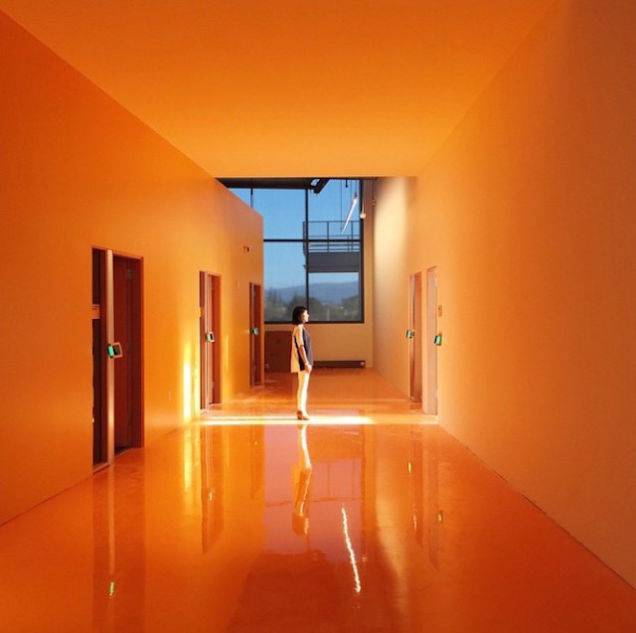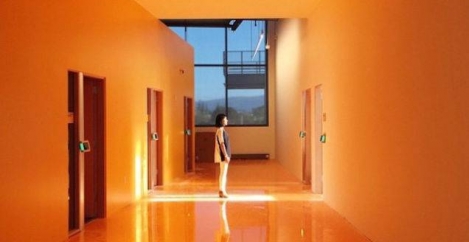March 29, 2024
FAANGs for the memories: how tech palaces lost their lustre
 I was alerted by the great Jack Pringle during a presentation course he was giving to an unforgettable YouTube clip of Steve Jobs speaking to the local council as part of a planning application for his Apple Park in California, one of the great tech palaces that sprang up in the wake of the digital revolution. Jobs, in familiar black polo neck jumper and wire-rimmed spectacles, took the officials of Cupertino City Council on a journey of opportunity, awe and inspiration.
I was alerted by the great Jack Pringle during a presentation course he was giving to an unforgettable YouTube clip of Steve Jobs speaking to the local council as part of a planning application for his Apple Park in California, one of the great tech palaces that sprang up in the wake of the digital revolution. Jobs, in familiar black polo neck jumper and wire-rimmed spectacles, took the officials of Cupertino City Council on a journey of opportunity, awe and inspiration.
Designed in close collaboration with Norman Foster and his practice, Jobs eschewed the idea of a business park and instead emphasised the idea of a nature refuge with green spaces to the fore and an artificial pond in the centre of the circle-shaped building. He talked passionately of this not being the cheapest way to build something…with every panel of glass in the main building curved. “We have a shot at building the best office building in the world. I really do think that architecture students will come here to see it.”
The structure had a fanatical amount of detail from the furniture harvested from a specific species of maple to the heavy hollow concrete slabs that acted as a then-innovative HVAC system. The building would not only be best-in-class for the occupants but would also be a benchmark for energy efficiency with its mix of solar panels and fuel cells powered by biofuel or natural gas. The doughnut shaped structure had hit a sweet spot of office culture back then in the 2010s. And that 2011 Jobs’ speech is a lesson in oratory and authority back when tech firms, especially those part of what was called the FAANG group of companies: Facebook (main image), Apple, Amazon, Google, Netflix were considered the last word in innovative workplace design as well as highly desirable employers.
The dream is over
Fast forward to 2023 and we have Sam Bankman Fried, appearing in front of the US judiciary and eventually being convicted of fraud for serious mismanagement of the firm he founded, FTX, a crypto currency exchange. The tech entrepreneur cuts a bizarre figure with his wild hair, high pitched voice, and board shorts as corporate uniform, not to mention his seeming disregard for the future of the investors who bought into him and his crypto brand and for whom a $billion worth of crypto currency’s value disappeared almost overnight thanks to his irregular financial practices.
Journalist Helen Lewis, writing as The Bluestocking on Substack talks of “The word that captures him more than any other is careless. He is careless of his appearance, careless of other people’s feelings, and careless of their money.’ I would add he has a carelessness towards workplace design too.
In November 2022, it was reported that one of FTX’s business units has spent $300 million in the Bahamas on homes and vacation properties for senior staff with ‘personal fiefdom’ the best description of Bankman Fried’s approach to designing and running a corporate headquarters. He and several colleagues lived together in what appears to be an overgrown frat house with free food and personal transportation around the island. Reuters reports how “The FTX headquarters is now unoccupied, with furniture pushed against some windows. Its signage has been removed. The plot of land, which cost $4.5 million, also lies empty.” One suspects not a lot of thought went into the real estate decisions nor the interior fit-out – Steve Jobs would be turning in his grave.
For a while Bankman Fried and indeed working style – playing computer games during meetings, spilling popcorn all over his private jet, working through the night to fuel his crypto dream was somewhat feted and he was even the subject of a book by Michael Lewis, the journalist responsible for writing The Big Short and Moneyball. In the podcast below, Lewis talks at length about the bizarre, cautionary history of this office. Such devotion beyond the 9-5 to something approaching 24/7 has long been par for the course in the tech sector. Apple’s was, after all, the latest in a long line of campus buildings where the workforce’s every need was catered for so that they’d never need to leave.
The heyday of tech palaces
Of course the daddy of this principle is the Googleplex in Mountain View in California which together with the firm’s Eighth Avenue building in New York occupy the top two spots in terms of the tech firm’s largest square footage. This corporate campus has had a few iterations in its time from the original SGI Campus built on the site of a working farm with its plethora of water features, pathways, and plazas to the design in 2005 by Clive Wilkinson Architects which saw the headquarters furnished with items such as giant rubber balls and a piano. Facilities ranged from laundry rooms to swimming pools, a bowling alley and over a dozen cafeterias. As of this year, it’s not just the tech giant’s staff who can marvel at this workplace. A visitors’ centre is open to the public and includes a store, café and selection of public art.
Personally I remember marvelling at the time not only at the Project Jack ‘hackable’ rooms by AHMM but the sleep pods elsewhere in Google’s King’s Cross HQ. Now, a bit wiser to different user group’s needs, I’d probably be more impressed with a wellness room, a parents’ room, or a design that better embraced neurodiversity.
Author Dave Eggers even took the idea of the tech campus to its nightmarish conclusion in his 2013 book The Circle which tells the story of a tech company run by a trio of tech bros who develop a real time camera for politicians to don to show their transparency but really exposes the influence the tech sector has on society, in this case with the Orwellian mantra of ‘secrets are lies, sharing is caring, privacy is theft.”
I think we are seeing a shift in that work-till-you-drop ethos though. An interesting case in point is the decline of the ‘girl boss’. Where once this embodiment of a busy young woman managing her empire, sharing her time-poor lifestyle over social media, now we have TikTok to thank for the rise of ‘lazy girl jobs’. This is a phenomenon coined by content creator Gabrielle Judge who espoused the value of a position with low stress, that was largely remote, well remunerated and with little to no interference from management as well as a clear work life balance. She uses her own previous work schedule of 50-60 hour weeks which took its toll on her health and it was this that led her to rethink what work really is.
The message of lazy girl jobs resonated with many on the platform with millions of views and hashtags. This viewpoint is in direct contrast to the girl boss’s and indeed tech bros’ eat, work, sleep repeat regimes and the accompanying tech palaces that facilitate this type of workstyle.
The same reappraisal of work and life has been made by those who are likely more familiar with Friendsreunited than TikTok. The number of over 50s who are ‘economically inactive’ has shot up post pandemic with half a million leaving the workforce without returning since March 2020. The reasons for this are multiple from homeowners who have paid their mortgages off and are comfortably enough off to stop work to those who are suffering from mental or physical health conditions.
Going remote (or not)
Looking back over twenty years, like a lot of elements of the Noughties, from non-inclusive fashion to the pre-crash activity of financial institutions, watching the Social Network and seeing Zuckerberg et al slaving away the offices of a tech company just doesn’t look that appealing anymore. Indeed Meta’s recent moves in real estate are a case in point. Recently it was revealed that Facebook’s parent company paid nearly £150m to break the lease on a building in Regent’s Park, London two years after committing to the space which is owned by developer British Land.
It is thought employees’ lack of appetite for returning to the office could be part of the reason for this about face. Just like companies that have been around for decades, even centuries, newer employers on the block like tech firms share the same dilemma in getting staff to come in the physical workspace. From Lloyds of London to Aviva and from Google to Amazon there has been a careful consideration of carrot and stick approaches.
Workplace culture expert Bruce Daisley, muses on this theme in his Substack Make Work Better, ‘Destination employers, like Nike or big tech firms, seem intent on using their brand capital to move the dial towards their traditional working practices’ he writes. By ‘traditional’, we can take that to mean a big push to return to the office. While Daisley cites TikTok, Snapchat having already done the 4-day thing, I give you Elon Musk who set out his stall for Twitter, now rebranded as X, in March when he sent out a missive entitled ‘Remote work is no longer acceptable’ and detailing how the ‘office is not optional’ having toured the social media giant’s offices in San Francisco the day before and found the place half empty.
Daisley goes on to say that “in the wider job market WFH is remaining strong – and immensely popular. Working from home remains immensely popular for working parents, those with pets and for people with arduous commutes. It’s also been hugely popular with those whose jobs involve deep work and concentration.” And goes on to cites key statistics to back up his points – in the job market, roles are offering set ups with an average of a third of the week from home and research from Gallup suggests that 9 in 10 workers don’t want to return to the five-days-a-week pre-pandemic workplace norms. Frankly, Daisley says, a free bacon sandwich in the office does not cut it and staff would trade a pay cut for greater flexibility.
A new generation
And while not all workplace trends can be wholly neatly set against generational lines, it is interesting to note that Musk and Zuckerberg are considered geriatric millennials and very much defined by their jobs and their working practices – Musk’s call to arms was sent at 2:30 am after all. Research from Deloitte Digital found that while 86 percent of bosses say that work is a significant part of their identity, the same cannot be said for Gen Zers where the figure was 61 percent. Other issues where management and younger staff clash is the importance of empathy and the impact of work on mental health. One senses Elon Musk might not have a firm grasp of either of these issues.
The tale of Sam Bankman Fried is a cautionary one and not just one for those who thought they might get rich quick by following the crypto trend. It reminds us that tech bros of today are not bothered about whether a workplace makes its staff happy or whether it merely encourages poor decision-making, burnout and a myriad of other problems. But those entering the workforce are concerned about such things and so we might have to stop worshipping such false workplace gods as tech firms and look to those who know what they’re talking about to gain the best insights into the world of workplace.
This article appears in Issue 18 of IN Magazine


Helen Parton is head of content at Informare, and an internationally renowned writer, commentator, curator and editorial consultant within the design, architecture and built environment sectors.



















